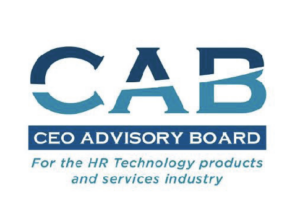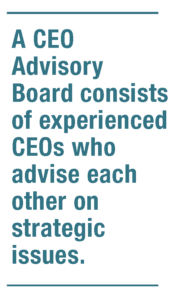Cindy’s Story
In 2010, I started an e-learning courseware company with another person – 50/50 owners. As the saying goes, “It worked well until it didn’t.” About five years in, my co-founder and the technical leader of the organization decided she did not like what she was doing and had a calling to be an author. It took her about six months to be honest about her desire to change. During those six months, there was a marked decrease in her productivity, innovation, problem-solving, and energy. Eventually, we agreed about her leaving, and I bought her out. Those six months and the following months, while I recruited a replacement, were professionally the most challenging months I went through during my entire career. If I had been a member of a CEO Advisory Board, the transition could have been smoother and much shorter for me and the business.
Nov’s Story
I started my business, Collective HR Solutions, in 2004, having left a major consulting firm. The impetus for doing so was pure speculation that I could do what I have done for over ten years, manage Western region businesses for other firms, and expand my network, knowledge, and wealth. But concentrating on the ability to sell consulting versus all the different dynamics of running a consulting business has been learned the hard way – trial and error and lots of backtracking. Having a peer group to bounce ideas, learn from others the dynamics of running a business, and build a network of potential partners would have likely been a more fruitful pursuit of efforts and given a better framework upon which to grow the business.
Hence, the building of a CEO Advisory Board for the many new startups we have met that can benefit from the wealth of knowledge being offered by our peers. They say, “What goes around comes around,” and Cindy and I believe this safe environment is the new method of sharing and growing.
of knowledge being offered by our peers. They say, “What goes around comes around,” and Cindy and I believe this safe environment is the new method of sharing and growing.
So, what is a CEO Advisory Board? A CEO Advisory Board consists of experienced CEOs who advise each other on strategic issues. Some groups provide accountability for acting on agreed-upon action items. The CEO Advisory Board members are not fiduciaries. Members meet regularly to discuss each other’s business problems, opportunities, the markets and the economy, and strategies to address all the topics. Each member receives advice, input, or feedback from the other members. For the groups that include accountability, the CEO who received advice, information, or feedback reports back on progress at the next meeting, gaining additional input from their peers. It is truly a “CEO Sounding Board.”
A CEO Advisory Board member’s ultimate goal is to continue building their businesses – Revenue Growth, Profitability Improvement, Geographical Expansion, and some organizational “top of mind” HR concerns, including the hybrid workforce, productivity, mental health, developing leaders, and perceived loss of culture. According to a study by Vistage, “CEO members grew their annual revenue on average by 4.6% in 2020, while nonmembers with comparable small and midsize businesses saw revenue decrease by 4.7%. How do CEO Advisory Boards help CEOs build their company? There are four main ways:
- Decision-making input. How many employees tell the CEO “the truth, the whole truth?” Not many, if any. Many employees will paint a picture so that the problem is not as bad as it is or that it portrays their team better. Or, while brainstorming, are employees more likely to say what they think the CEO wants to hear or push ideas that go against the CEO’s current thinking? Information and opinions presented to the CEO are filtered or slanted. Without the best information, making the best decisions possible is impossible. Through a CEO Advisory Board, the peers have nothing to lose except to tell the truth as they see it. And in a group discussion on options, the wealth of information shared and discussed may lead to better plans that the CEO can execute. The result is that the company does better, the CEO feels better, and the employees feel that their CEO is talking with
 others. This opens the opportunity that employees CAN tell the truth, as their CEO is willing to hear those thoughts from other sources.
others. This opens the opportunity that employees CAN tell the truth, as their CEO is willing to hear those thoughts from other sources. - Confidants are hard to find at the CEO level; people you can respect, that can provide all the details of a situation openly and obtain candid feedback with no concerns of competition or malice. Within a CEO Advisory Board peer group, the members are selected for non-competing businesses, so there is no concern about intellectual property being shared inappropriately. Still, similar markets are being discussed on how to approach, sell, and retain, so there are relative similarities among the groups.
- Mentors are currently seen as the way to accelerate a person’s career. Consistent interaction, guidance, and oversight of projects with specific outcomes are the earmarks of an excellent mentoring program. CEOs are simply people with a “higher title” than new employees, but it does not mean they cannot learn, may be new to that role, and would more than likely be better oriented through mentoring from someone further down the CEO path. The CEO Advisory Board is like getting a group of mentors to help an individual on their journey.
- Connections have always been the method of growing knowledge, prospects, and reputation. Within a peer group, one can meet new individuals whose networks are possibilities to leverage. With non-competing businesses in the group, you can share contacts, partner with another member and their network, or go to market with a more robust offering through collaboration.
CEO Advisory Groups usually have an independent facilitator that provides structure to meetings, ensures clear objectives for the conference, offers additional perspectives to the group’s comments, and ensures value within each gathering. This provides additional value to the individuals and the group in that everyone benefits through the efforts of the facilitator to ensure everyone is heard and is allowed to achieve their objectives.
A good facilitator will also have a network of consultants, vendors, and experts to bring to these meetings to provide additional insights, anecdotes, and real-life approaches to solving problems that add to the shared knowledge.
In my experience, over years of meeting startup founders, I have found that the “idea person” is usually new to a CEO role. The initial “thought or solution” by the person starting a business is composed of the desire to address a problem “known” to them, the energy to solve that problem, and perhaps the knowledge to create a process, service, or app to provide to others experiencing that problem and solve it. And typically, it is a view and approach that can lead to many missteps and failure to deliver on the idea without understanding the complex discipline of running a company.
The gap between having the solution and selling that solution to a buying audience is the difference a CEO and a well-run organization can address. But the problems of selling, marketing, supporting, managing, and growing are generally not the strengths of that “idea person.”
To me, belonging to a CEO Advisory Board is like going to summer camp. Someone will help to direct your growth through a more structured path, giving you projects to accomplish, sharing new ideas, allowing you to make friends and learn to work together, and allowing you to return home with knowledge and fresh ideas to put into place for your organization.
Given the unpredictable environment and economy, using a peer network, as evidenced by teamwork and collaboration at other levels of the organization, should provide a new outlet for CEOs to share and learn together.
References
State of the Market Report, https://bit.ly/47OSC1N.
Vistage Study, https://bit.ly/45yPMvw.




